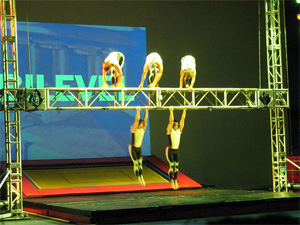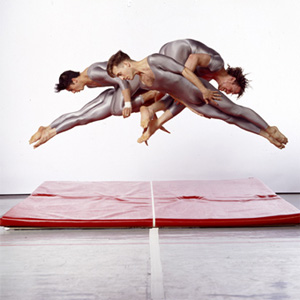4.) The Highly Skilled Body

Dancers, athletes and others elect to enhance their physical opportunities to optimally perform specific kinds of tasks. Various systems of training methods, of which dance training is one, are designed to increase strength, flexibility, speed, and movement fluidity or efficiency, for example. Bodies that undergo such rigorous training systems over time to perform specific physical tasks not only tend to become highly skilled at these tasks, but are often altered in appearance through the development of muscle mass and tone; these bodies also connote, through appearance and function, such social values as health and physical fitness.
Using discussion format, ask students to consider the following:
- What kinds of physical tasks require specific bodily training systems?
- In what ways/can bodies that are trained to do extraordinary tasks be considered as altered bodies?
- How are bodies that are highly trained to perform specific physical tasks viewed in current US society?
Classroom Activities:
- Collect the assigned paragraphs of student findings about the ways their bodies resemble machines.
- Possibilities for discussion of assignment:
- How is the body like a machine?
- Are there examples when the whole body functions as a machine?
- Are there examples of specific body parts functioning as machines?
- What kinds of machines does the body resemble?
- How does the body differ from a machine?
- View the footage of Elizabeth Streb’s work Wild Blue Yonder.
- Invite students to think back over what they have observed in this viewing.
- Invite students to generate lists of action words that describe the movement they have just witnessed.
- From students’ individual lists, elicit a collective list of verbs.
- As students contribute these action ideas, give their words group representation, on the display surface.
Discussion Questions:
- What kinds of mediating strategies does Streb use to instigate the movement choices that the students have listed?
- How has Streb constructed and organized the performing space to evoke particular movement responses?
- What kinds of machines or apparatuses are employed in the work?
- Are the bodies manipulating these machines?
- Are the machines manipulating the bodies?
Further Discussion:
Having reviewed the kinds of actions characteristic of Elizabeth Streb’s movement vocabulary, invite students to discuss their own physical, kinesthetic responses to observing this movement:
- Was it exciting?
- Was the movement scary?
- Was it predictable?
- Did it resemble everyday movement?
- Did special physical training seem to be necessary to carry out these activities?
- Did students feel included or excluded as they watched this work? That is, did they feel inclined to participate in this kind of movement themselves or did they feel “put off” by or unable to participate in this kind of movement?
Assignment:

Find three new examples of movement at home that are related to machines, and identify whether the body is primarily active or passive in each of these instances? Does the machine assist or incapacitate the body in some way?
- Bring in examples of artists today who use details from their lives—their experiences, their travels, their personal relationships—as inspiration for the creation of their music, visual art, literature and poetry, or dance.
- Research American literature that reflects themes of social and political protest. Poetry is a good choice to focus on since that is the literary form Primus drew upon to inspire several of her dances. Students will be making their own dances in a later classroom activity and might include excerpts from these writings.
- Read John Perpener’s article on Jawole Willa Jo Zollar

